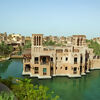10 Nights | India
About Abu Dhabi, United Arab Emirates
You will visit the following 6 places:

Dubai
Dubai is the most populous city and is one of the seven emirates of the United Arab Emirates (UAE). It is located south of the Persian Gulf on the Arabian Peninsula and has the largest population with the second-largest land territory by area of all the emirates, after Abu Dhabi. Dubai and Abu Dhabi are the only two emirates to have veto power over critical matters of national importance in the country's legislature. It is rather like an independent city-state and is the most modern and progressive emirate in the UAE, developing at an unbelievable pace in the tourist and trade sectors especially. Recently Dubai won the bid to host EXPO 2020, a Universal scale Registered Exposition approved by the Bureau of International Expositions (BIE), Paris.

Abu Dhabi
Abu Dhabi, the capital and the second largest city in the United Arab Emirates, lies on a T-shaped island jutting into the Persian Gulf from the central western coast. The city is also one of the most modern cities in the world. Abu Dhabi features large gardens and parks, green boulevards lining all the streets and roads, sophisticated high-rise buildings, international luxury hotel chains and opulent shopping malls.

Doha
Doha is the capital city of the state of Qatar. Located on the Persian Gulf, it had a population of 998,651 in 2008, and is also one of the municipalities of Qatar. Doha is Qatar's largest city, with over 80% of the nation's population residing in Doha or its surrounding suburbs, and is also the economic centre of the country. Doha also serves as the seat of government of Qatar, which is ruled by Sheikh Hamad bin Khalifa Al Thani. Doha is home to the Education City, an area devoted to research and education. Doha was the site of the first ministerial-level meeting of the Doha Development Round of World Trade Organization negotiations.

Mascat
Muscat is the capital of Oman. It is also the seat of government and largest city in the Governorate of Muscat. As of 2008, the population of the Muscat metropolitan area was 1,090,797. The metropolitan area spans approximately 580 square miles and includes six wilayats. Known since the early 1st century CE as an important trading port between the west and the east, Muscat was ruled by various indigenous tribes as well as foreign powers such as the Persians and the Portuguese Empire at various points in its history. A regional military power in the 18th century, Muscat's influence extended as far as East Africa and Zanzibar. As an important port-town in the Gulf of Oman, Muscat attracted foreign tradesmen and settlers such as the Persians, the Balochs and Gujaratis.

Al Manama

Khasab
Khasab is a city in an exclave of Oman bordering the United Arab Emirates. It is the local capital of the Musandam peninsula and has frequently been dubbed the "Norway of Arabia" because of its extensive fjord-like craggy inlets and desolate mountainscapes. The Portuguese built Khasab at the beginning of the 17th century, at the height of their naval presence in the region. The natural harbour gave shelter from tough seas. Unlike many forts, which were built on high ground for defensive purposes, Khasab was designed as a supply point for dates and water for Portuguese ships sailing through the strait. Today, Khasab is protected from floods by three large dams.










